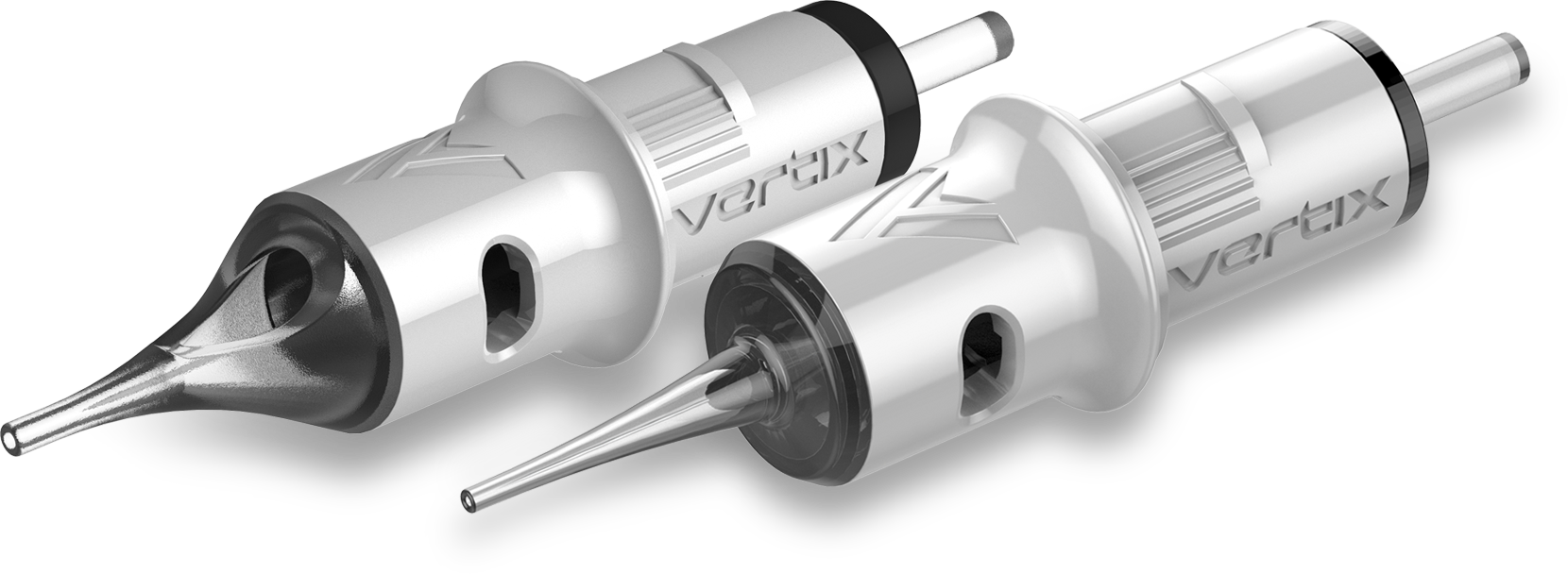Tattoo needle configurations guide
The below guide is one of the several downloads from the course and is a suggestion on tattoo needle types and the usages.
To your PMU success,

PMU Artist & Needle Specialist
Inside Needle Knowledge
Purchase the I.N.K. Course Now
IG jillhoyer
DRAG AND DROP THE NEEDLE GUIDE TO YOUR DESKTOP

Have you heard of the saying, "it doesn't matter what needle you choose, just as long as you know how to use it." If you're a new PMU artist or a seasoned artist who is just venturing out of using a couple of different needle configurations, this is a frustrating statement. How do you know how to use needles when you never were taught needle theory in basic fundamental training? Today, there is a big need for needle theory. How to use needles makes much more sense when we understand the basics of what we are using and why we are using it. Needles our important as they dictate the footprint left behind in the skin.
In the online course, www.insideneedleknowledge.com, I further explain...
The Single Needle Pixel Effect
Can you believe all the single needle sizes available in today's PMU market?
The single needle used during the "fine line" era of traditional tattooing for entire tattoos, has been primarily used in PMU for pointillism, hair strokes and a shaded effect known as "the pixel technique." Although most needles could be used to do the pixel technique, this video and article is mainly about the single needle sizes used to pixel and when you may choose one size over the other.
Using a single needle or group of needles, the pixel technique is a combination of machine speed and hand speed that creates a dot like pattern in the skin. The slower the hand speed the closer the dots and the faster the hand speed the further the dots are apart. With the pixel technique, there is skin space between pixels and this lends to a soft look similar to powder.
With so many different sizes and tapers of single needles available, which sizes are optimal for pixelating? Based on my experiences and needl...
Liner-Shader Guide
As PMU artists we have a lot of needle choices. I use to think I could only use liners for lining and shaders for shading. I realized I can use any needle, just as long as I know how to use it. Of course, some needles are better "tools" for the procedure at hand, but I've learned not to limit myself in my needle choices just because they are called a liner or shader.
Knowing how to use a variety of needles with several techniques saves time during procedures as you don't always need to switch needles or have two machine setups. More importantly, is the artistry that develops in understanding our needle patterns or "footprint" from both liners and shaders and using them interchangeably.
Since liner needles (more than a single needle) are typically closer together than shader needles, the pattern/imprint of color is denser. You may come across situations where you want to shade with liners or use a shader needle, with it's broader pattern that covers more surface area and deliver...
Tattoo Needle Sizes and Tapers
With so many needle choices today it can be a bit confusing. Starting with the basics, the video explains all about our needle size systems and tapers.
To your PMU success,

PMU Artist & Needle Specialist
Inside Needle Knowledge
Powder Brows make a comeback as Ombre Brows
Imagine how pleased I was to see in the latest on-line edition of Skin Ink that the Ombre eyebrow technique received a lot of praise and attention. My admiration for the Blended Brow™ (a version of the Ombre or combo brow) did not happen overnight. I am an entrepreneur; I create and I remain current in my profession. I too, as many have, admired the immediately after appearance of the hairstroke, microblading, embroidery brows, or whatever marketing names were used, but I know the skin, and I know needles, and I know how pigments/inks behave in the skin over time. I, and other PMU artists, already anticipated what the hair strokes (and all associated marketing names used for lines in the brows that mimicked the appearance of eyebrow hairs) would not remain crisp, have the expected longevity, and that clients would ultimately request more brow coverage that would last longer.
Based on my client’s input, regardless of how attractive the name or the media pictures they saw of the tec...
Tattoo Cartridge Needles, to membrane or not?
A lot of PMU and Tattoo artists use a pen-style tattoo machine today and needle cartridges should have membranes when used with these machines to prevent backflow into the machines and cross-contamination.
A cartridge may look like it has a membrane but there are a couple of tests to be sure! The easiest test is to use water or ink to test the membrane for leakage. (see video). The other way is to actually blow on the back end of a needle cartridge. If you hear air, there can be a possibility of backflow into your machine. DONT USE TEST NEEDLES ON CLIENTS!
Why would manufacturers even make needles without a cartridge? Keep in mind that some tattoo machines have a separate grip from the motor. So, in that case, you could use any needle as it's not leaking back into the machine..... if it leaks, it's only into the disposable or autoclavable grip.
Tattoo Needle Class
“I almost missed this class thinking I knew enough about needles. Wrong.”
Investing in your knowledge and skills is paramount to satisfying clients and attracting more. The I.N.K. Masterclass is designed to get you there – no need to rely on guesswork, be confident in your needle choices. Take the course at your own pace and repeat as many times as you need to.
Take this opportunity now and make your PMU world a huge success and know your needles!
To your PMU success,

PMU Artist & Needle Specialist
Inside Needle Knowledge, I.N.K.
Q & A With Tattoo Needle Course (Inside Needle Knowledge) Creator Jill Höyer
Q/A with Jill Höyer about the online needle course, Inside Needle Knowledge.

Q: What prompted you to develop the Inside Needle Knowledge (INK) program?
A: There’s a need for needle education in our industry. Many artists initially use one or 2 types of needles they learned on and find it intimidating to try new needles. I like to say, “the more you know, the more you’ll grow.” If artists really understand needles they will start combining various needles, techniques, and develop their own style.
Q: Why did you choose this format for the program?
A: I like the idea of a platform where you can watch the course 24/7 and re-watch the course and download the pdfs for reference. I like how the course is set up with lessons that you can easily replay as needed plus you can post questions after each lesson or email me privately for answers.
Q: How long have you been studying needles?
A: I’ve done permanent makeup for 15 years. From day one I was intrigued but didn’t understand...
New tattoo needle cartridges fit nicely on pen style tattoo machines.
The new cartridge tattoo needle by TatSoul has some nice features. Having used their quality, smooth running needles in the past I had to try this cartridge with a soft silicone finger ledge. It's like a squishy pencil holder.
 What I found a huge plus is the way the Envy finger ledge integration fits into the pen style tattoo machine making it easy for the way I wrap my machine for cross-contamination prevention.
What I found a huge plus is the way the Envy finger ledge integration fits into the pen style tattoo machine making it easy for the way I wrap my machine for cross-contamination prevention.
Another style needle cartridge is the Vertix tattoo needle cartridges. Both the TatSoul and Vertix tattoo cartridge needles are great quality, have a lip on the cartridge making it fit nicely up to the edge of the machine tip, and they both have a membrane that prevents the backflow of ink into the machine.
To your PMU success,

PMU Artist & Needle Specialist
Inside Needle Knowledge, I.N.K.
Manual vs Machine Tattoo Needles

I want to share a question I was asked from a PMU artist seeking information about my I.N.K. course and sizes relevant to microblading needles and digital or machine tattoo needles. If you've wondered the same question about the course or needles, hopefully, this helps!
Message: Hi Jill
Please, can you advise if your I.N.K. course is relevant to microblading needle configurations as well as digital? Thanks, D.
Me: Hi D.
In general, many aspects of the lessons on needles apply to both machine and manual type needles. As an artist, I use both manual and machine needles.
Maybe you have a specific question I can answer?
Message: Thanks for getting back to me so quickly. I’ve got an understanding of the different configurations. It’s just understanding the benefits (or should I say drawbacks) of the different gauges of needles. For example, 0.16 needles provide a crisper line, however, when shouldn’t they be used. And 0.20 gauge. Is there a lesson you would recommend f...


